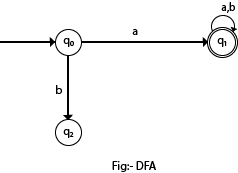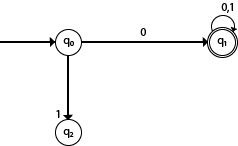DFA (Deterministic finite automata)
- DFA refers to deterministic finite automata. Deterministic refers to the uniqueness of the computation. The finite automata are called deterministic finite automata if the machine is read an input string one symbol at a time.
- In DFA, there is only one path for specific input from the current state to the next state.
- DFA does not accept the null move, i.e., the DFA cannot change state without any input character.
- DFA can contain multiple final states. It is used in Lexical Analysis in Compiler.
In the following diagram, we can see that from state q0 for input a, there is only one path which is going to q1. Similarly, from q0, there is only one path for input b going to q2.

Formal Definition of DFA
A DFA is a collection of 5-tuples same as we described in the definition of FA.
- Q: finite set of states
- ∑: finite set of the input symbol
- q0: initial state
- F: final state
- δ: Transition function
Transition function can be defined as:
- δ: Q x ∑→Q
Graphical Representation of DFA
A DFA can be represented by digraphs called state diagram. In which:
- The state is represented by vertices.
- The arc labeled with an input character show the transitions.
- The initial state is marked with an arrow.
- The final state is denoted by a double circle.
Example 1:
- Q = {q0, q1, q2}
- ∑ = {0, 1}
- q0 = {q0}
- F = {q2}
Solution:
Transition Diagram:

Transition Table:
| Present State | Next state for Input 0 | Next State of Input 1 |
|---|---|---|
| →q0 | q0 | q1 |
| q1 | q2 | q1 |
| *q2 | q2 | q2 |
Example 2:
DFA with ∑ = {0, 1} accepts all starting with 0.
Solution:

Explanation:
- In the above diagram, we can see that on given 0 as input to DFA in state q0 the DFA changes state to q1 and always go to final state q1 on starting input 0. It can accept 00, 01, 000, 001….etc. It can’t accept any string which starts with 1, because it will never go to final state on a string starting with 1.
Example 3:
DFA with ∑ = {0, 1} accepts all ending with 0.
Solution:

Explanation:
In the above diagram, we can see that on given 0 as input to DFA in state q0, the DFA changes state to q1. It can accept any string which ends with 0 like 00, 10, 110, 100….etc. It can’t accept any string which ends with 1, because it will never go to the final state q1 on 1 input, so the string ending with 1, will not be accepted or will be rejected.
- Theory of Automata
- Finite Automata
- Transition Diagram
- Transition Table
- DFA (Deterministic finite automata)
- Examples of DFA
- NFA (Non-Deterministic finite automata)
- Examples of NFA
- Eliminating ε Transitions
- Conversion from NFA to DFA
- Conversion from NFA with ε to DFA
- Minimization of DFA
- Regular Expression
- Examples of Regular Expression
- Moore Machine
- Mealy Machine
- Context Free Grammar
- Simplification of CFG
- Chomsky’s Normal Form (CNF)
- Greibach Normal Form (GNF)
- Pushdown Automata(PDA)
- Non-deterministic Pushdown Automata
- Turing Machine
- Examples of TM

